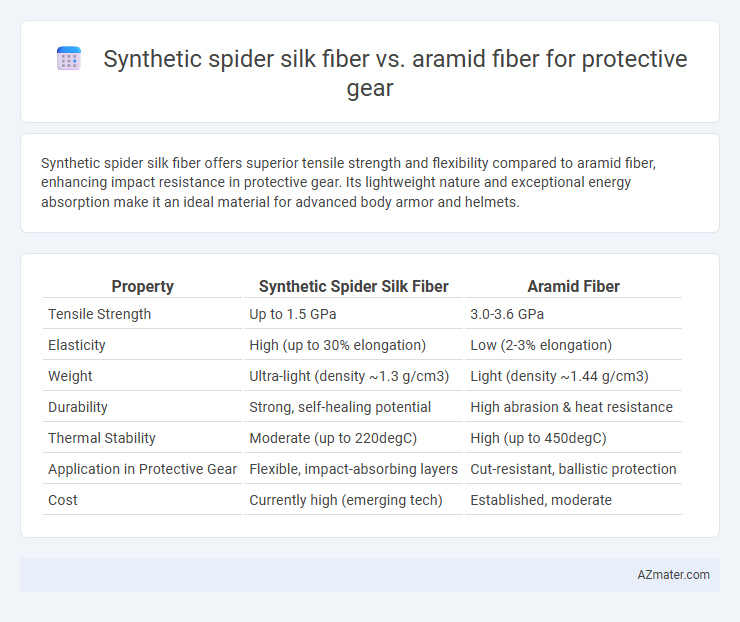Synthetic spider silk fiber offers superior tensile strength and flexibility compared to aramid fiber, enhancing impact resistance in protective gear. Its lightweight nature and exceptional energy absorption make it an ideal material for advanced body armor and helmets.
Table of Comparison
| Property | Synthetic Spider Silk Fiber | Aramid Fiber |
|---|---|---|
| Tensile Strength | Up to 1.5 GPa | 3.0-3.6 GPa |
| Elasticity | High (up to 30% elongation) | Low (2-3% elongation) |
| Weight | Ultra-light (density ~1.3 g/cm3) | Light (density ~1.44 g/cm3) |
| Durability | Strong, self-healing potential | High abrasion & heat resistance |
| Thermal Stability | Moderate (up to 220degC) | High (up to 450degC) |
| Application in Protective Gear | Flexible, impact-absorbing layers | Cut-resistant, ballistic protection |
| Cost | Currently high (emerging tech) | Established, moderate |
Introduction to Synthetic Spider Silk Fiber and Aramid Fiber
Synthetic spider silk fiber mimics the natural protein structure of spider silk, offering exceptional tensile strength, elasticity, and lightweight properties ideal for protective gear. Aramid fiber, such as Kevlar, is a heat-resistant and strong synthetic fiber widely used in ballistic and cut-resistant applications due to its high durability and impact resistance. Both fibers provide advanced protection, with synthetic spider silk excelling in flexibility and biodegradability, while aramid fiber is renowned for its proven high-performance in extreme conditions.
Material Composition and Structure Comparison
Synthetic spider silk fiber consists of protein-based polymers that mimic natural spider silk's hierarchical nanofibril structure, offering high tensile strength and exceptional elasticity. In contrast, aramid fiber, composed of aromatic polyamides such as Kevlar, features rigid molecular chains with strong intermolecular hydrogen bonding that provide excellent heat resistance and impact protection. The proteinaceous, flexible nature of synthetic spider silk enables superior energy absorption and lightweight durability, while aramid fibers excel in thermal stability and abrasion resistance, influencing their distinct protective gear applications.
Mechanical Strength and Toughness
Synthetic spider silk fiber exhibits exceptional mechanical strength and toughness, rivaling or surpassing traditional aramid fibers such as Kevlar used in protective gear. Its tensile strength ranges between 1.0 to 1.5 GPa, combined with remarkable elasticity and energy absorption capacity, which enhances impact resistance and durability. Aramid fibers offer high tensile strength around 3.5 GPa but are more brittle, leading to lower toughness compared to the highly flexible and damage-tolerant synthetic spider silk.
Flexibility and Comfort in Protective Gear
Synthetic spider silk fiber offers superior flexibility and comfort compared to aramid fiber, enabling enhanced dexterity and reduced wearer fatigue in protective gear. Its lightweight and high elasticity allow for greater movement freedom while maintaining excellent tensile strength and impact resistance. In contrast, aramid fiber, although highly durable and heat-resistant, tends to be stiffer and less breathable, which can compromise comfort during extended use.
Resistance to Environmental Factors
Synthetic spider silk fiber exhibits remarkable resistance to UV radiation, moisture, and temperature fluctuations, maintaining structural integrity in harsh environmental conditions. Aramid fibers, such as Kevlar, offer strong chemical and heat resistance but can degrade under prolonged UV exposure and high humidity. The superior environmental durability of synthetic spider silk makes it an emerging material for next-generation protective gear with enhanced longevity and performance.
Weight and Thickness Considerations
Synthetic spider silk fiber offers significantly lower weight and reduced thickness compared to aramid fibers, enhancing mobility and comfort in protective gear applications. Its high tensile strength and elasticity allow for lighter, thinner layers without compromising protection, whereas aramid fibers, such as Kevlar, tend to be bulkier and heavier to achieve similar levels of defense. Optimizing weight and thickness with synthetic spider silk fibers enables the development of advanced protective garments that maintain safety standards while improving wearer agility.
Manufacturing Processes and Scalability
Synthetic spider silk fiber manufacturing involves bioengineering proteins through genetically modified organisms, followed by complex spinning processes that mimic natural silk production, enabling a renewable and potentially scalable fiber. Aramid fibers, produced through synthetic polymerization and solution spinning methods, benefit from well-established industrial-scale manufacturing with consistent quality and high throughput. While synthetic spider silk offers superior biodegradability and mechanical properties, aramid fibers currently dominate the protective gear market due to their mature, cost-effective, and scalable production infrastructure.
Cost Analysis and Market Availability
Synthetic spider silk fiber offers promising mechanical strength and flexibility, yet its high production cost currently limits widespread adoption in protective gear compared to Aramid fiber, which remains more cost-effective and readily available on the market. Aramid fibers, such as Kevlar, benefit from established manufacturing processes and extensive supply chains, resulting in lower prices and higher accessibility for industries requiring ballistic and cut-resistant materials. Market analysis reveals that despite synthetic spider silk's superior performance potential, Aramid fibers dominate due to scalability and affordability advantages in protective gear applications.
Sustainability and Biodegradability
Synthetic spider silk fiber offers superior sustainability compared to aramid fiber due to its renewable production process leveraging bioengineered proteins, resulting in significantly lower environmental impact. In terms of biodegradability, synthetic spider silk breaks down naturally in the environment within months, whereas aramid fibers like Kevlar persist for decades, contributing to long-term waste. Protective gear made with synthetic spider silk combines high strength with eco-friendly disposal, making it a more sustainable choice over traditional aramid materials.
Future Prospects and Innovation in Protective Gear Materials
Synthetic spider silk fiber exhibits exceptional tensile strength and elasticity, surpassing aramid fibers like Kevlar in durability and biodegradability, which positions it as a disruptive innovation in protective gear. Ongoing research aims to enhance production scalability and cost-efficiency of synthetic spider silk, potentially revolutionizing body armor and helmets with lighter, stronger, and more flexible materials. Integration of synthetic spider silk with nanotechnology and smart textiles is paving the way for next-generation protective gear featuring improved impact resistance and adaptive performance.

Infographic: Synthetic spider silk fiber vs Aramid fiber for Protective gear
 azmater.com
azmater.com